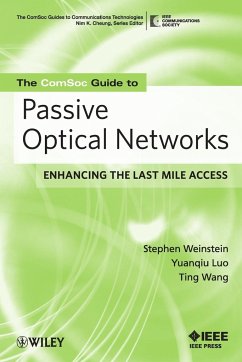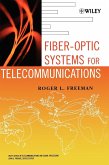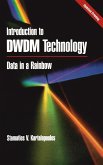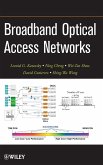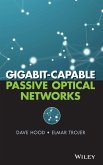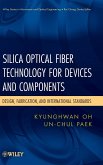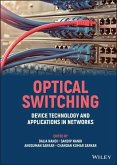Stephen B. Weinstein, Yuanqiu Luo, Ting Wang
The Comsoc Guide to Passive Optical Networks
Enhancing the Last Mile Access
Stephen B. Weinstein, Yuanqiu Luo, Ting Wang
The Comsoc Guide to Passive Optical Networks
Enhancing the Last Mile Access
- Broschiertes Buch
- Merkliste
- Auf die Merkliste
- Bewerten Bewerten
- Teilen
- Produkt teilen
- Produkterinnerung
- Produkterinnerung
This book provides a brief, high-level overview of the technology and applications behind the Fiber-to-the-Home (FTTH) or Fiber-to-the-Curb (FTTC) family of standards, which has recently attracted considerable amount of interest in the technical community. The goal of this book is to provide readers with knowledge of the key features of Passive Optical Networks (PON); the different types of PON architectures and standards; key issues of PON devices, management, and their implementation; and the leading participants and business opportunities in access networks. It's an indispensable reference for professionals in PON.…mehr
Andere Kunden interessierten sich auch für
![Fiber-Optic Systems for Telecommunications Fiber-Optic Systems for Telecommunications]() Roger L. FreemanFiber-Optic Systems for Telecommunications174,99 €
Roger L. FreemanFiber-Optic Systems for Telecommunications174,99 €![Introduction to Optical Waveguide Analysis Introduction to Optical Waveguide Analysis]() Kenji KawanoIntroduction to Optical Waveguide Analysis163,99 €
Kenji KawanoIntroduction to Optical Waveguide Analysis163,99 €![Introduction to Dwdm Technology Introduction to Dwdm Technology]() Stamatios V. KartalopoulosIntroduction to Dwdm Technology129,99 €
Stamatios V. KartalopoulosIntroduction to Dwdm Technology129,99 €![Broadband Optical Access Networks Broadband Optical Access Networks]() Leonid G KazovskyBroadband Optical Access Networks126,99 €
Leonid G KazovskyBroadband Optical Access Networks126,99 €![Optical Networks Optical Networks]() Dave HoodOptical Networks127,99 €
Dave HoodOptical Networks127,99 €![Silica Optical Fiber Technology for Devices and Components Silica Optical Fiber Technology for Devices and Components]() Kyunghwan OhSilica Optical Fiber Technology for Devices and Components122,99 €
Kyunghwan OhSilica Optical Fiber Technology for Devices and Components122,99 €![Optical Switching Optical Switching]() Optical Switching134,99 €
Optical Switching134,99 €-
-
-
This book provides a brief, high-level overview of the technology and applications behind the Fiber-to-the-Home (FTTH) or Fiber-to-the-Curb (FTTC) family of standards, which has recently attracted considerable amount of interest in the technical community. The goal of this book is to provide readers with knowledge of the key features of Passive Optical Networks (PON); the different types of PON architectures and standards; key issues of PON devices, management, and their implementation; and the leading participants and business opportunities in access networks. It's an indispensable reference for professionals in PON.
Produktdetails
- Produktdetails
- IEEE ComSoc Pocket Guides to Communications Technologies
- Verlag: Wiley & Sons
- 1. Auflage
- Seitenzahl: 200
- Erscheinungstermin: 8. Mai 2012
- Englisch
- Abmessung: 234mm x 156mm x 11mm
- Gewicht: 340g
- ISBN-13: 9780470168844
- ISBN-10: 0470168846
- Artikelnr.: 27006576
- Herstellerkennzeichnung
- Libri GmbH
- Europaallee 1
- 36244 Bad Hersfeld
- gpsr@libri.de
- IEEE ComSoc Pocket Guides to Communications Technologies
- Verlag: Wiley & Sons
- 1. Auflage
- Seitenzahl: 200
- Erscheinungstermin: 8. Mai 2012
- Englisch
- Abmessung: 234mm x 156mm x 11mm
- Gewicht: 340g
- ISBN-13: 9780470168844
- ISBN-10: 0470168846
- Artikelnr.: 27006576
- Herstellerkennzeichnung
- Libri GmbH
- Europaallee 1
- 36244 Bad Hersfeld
- gpsr@libri.de
George Weinstein is the award-winning author of the beloved Southern historical novel HARDSCRABBLE ROAD, its sequel RETURN TO HARDSCRABBLE ROAD (winner of the Literary Titan Book Award and Readers' Favorite Award Bronze Medal), the kidnapping thriller WATCH WHAT YOU SAY, the small town, amateur-sleuth murder mystery AFTERMATH, the modern domestic drama THE CARETAKER, and the multi-cultural novel of forgotten US history THE FIVE DESTINIES OF CARLOS MORENO. A popular speaker with book clubs and at literary festivals, George is fond of telling readers the stories behind the stories and providing writers with advice he wished he had received when he embarked on his so-called writing career in 2000.His work has been published in the Atlanta press and in regional and national anthologies, including A CUP OF COMFORT FOR WRITERS. His first novel, the children's motivational adventure JAKE AND THE TIGER FLIGHT, was written for the nonprofit Tiger Flight Foundation, which is dedicated to the mission of leading the young to become the "Pilot in Command" of their lives. He wishes that there had been such an organization in Laurel, Maryland, where he misspent his youth.George is the twice-former President of the Atlanta Writers Club (AWC / www.AtlantaWritersClub.org) and is its Executive Director. He also holds the lifetime title of Atlanta Writers Conference Director and manages two conferences per year (www.AtlantaWritersConference.com) for the AWC to give writers access to publishing house editors, literary agents, and other industry professionals. He lives with his wife and her two daughters in Marietta, GA.Information about George's books, excerpts, endorsements and reviews, book club questions, and more, are available on his website: www.GeorgeWeinstein.com.
Preface xi
1 PON in the Access Picture 1
1.1 Why Passive Optical Network (PON) for the Last Mile Access?, 1
1.2 Services and Applications, 4
1.2.1 Displacement of Legacy High-Speed Access Services, 4
1.2.2 Internet Protocol (IP) over PON, 6
1.2.3 Triple Play and Quadruple Play, 6
1.2.4 Multimedia Conferencing and Shared Environments, 8
1.2.5 Backhaul Services, 8
1.2.6 Cloud-Based Services, 10
1.3 Legacy Access Technologies, 10
1.3.1 Hybrid Fiber-Coax (HFC) Cable Data System, 10
1.3.2 Digital Subscriber Line (DSL), 13
1.3.3 Broadband over Powerline (BoPL), 15
1.3.4 Broadband Wireless Access (BWA), 16
1.4 Fiber-Optic Access Systems, 18
1.4.1 PON as a Preferred Optical Access Network, 20
1.5 PON Deployment and Evolution, 22
References, 24
2 PON Architecture and Components 27
2.1 Architectural Concepts and Alternatives, 27
2.1.1 Topologies, 27
2.1.2 Downstream and Upstream Requirements, 30
2.1.3 BPON, GPON, and EPON Systems, 30
2.1.4 Medium Access Techniques, 34
2.2 Passive and Active PON Components, 37
2.2.1 Passive Optical Coupler, 37
2.2.2 Splitter, 38
2.2.3 Arrayed Waveguide Grating (AWG), 40
2.2.4 Optical Line Termination (OLT), 41
2.2.5 ONU/ONT, 41
2.3 Management and Control Elements, 43
2.3.1 Bandwidth Allocation, 43
2.3.2 Quality of Service (QoS), 44
2.3.3 Deployment and Maintenance, 46
2.3.4 Problems and Troubleshooting, 47
References, 50
3 Techniques and Standards 53
3.1 BPON Overview, 55
3.1.1 Basic Asynchronous Transfer Mode (ATM) Concepts, 56
3.2 The Full Service Access Network (FSAN) (ITU-T G.983) BPON Standard, 58
3.2.1 Downstream Transmission, 62
3.2.2 Upstream Transmission, 64
3.2.3 Management Functions, 65
3.2.4 Wavelength Division Multiplexing (WDM), 65
3.2.5 Dynamic Bandwidth Allocation (DBA), 67
3.2.6 Protection Switching, 67
3.3 GPON, 68
3.3.1 GPON Encapsulation Method (GEM), 69
3.3.2 Downstream Transmission, 70
3.3.3 Upstream Transmission, 72
3.3.4 Ranging, 73
3.3.5 Security, 74
3.4 EPON, 74
3.4.1 EPON Switched Ethernet, 77
3.4.2 1000BASE-PX10, 1000BASE-PX20, and 10G EPON PMD Types, 78
3.4.3 Medium Access Control (MAC), 79
3.4.4 Comparison of 1G EPON and GPON, 83
3.4.5 Service Interoperability in EPON (SIEPON), 85
References, 86
4 Recent Advances and Looking to the Future 87
4.1 Interoperability, 87
4.1.1 Implementing 1:1 and 1:N Interoperability Testing, 89
4.1.2 Management and Quality-of-Service (QoS) Challenges, 91
4.2 Wavelength Division Multiplexed PON (WDM-PON), 91
4.2.1 Coarse Wavelength Division Multiplexing (CWDM)-PON and Dense
Wavelength Division Multiplexing (DWDM)-PON, 93
4.2.2 WDM Devices, 95
4.3 Subcarrier PON, 97
4.4 Long-Reach PON, 100
4.5 Optical-Wireless Integration, 100
4.5.1 Architecture, 101
4.5.2 Integration Modes, Benefits, and Challenges, 103
4.5.3 Support of Next-Generation Cellular Mobile, 106
4.5.4 The Future of Optical-Wireless Integration, 107
4.6 Scaling Up PON to Much Higher Transmission Rates, 108
4.7 Conclusion, 111
References, 111
Appendix: Excerpts from the IEEE 10 Gbps EPON Standard 802.3av-2009 115
Index 183
1 PON in the Access Picture 1
1.1 Why Passive Optical Network (PON) for the Last Mile Access?, 1
1.2 Services and Applications, 4
1.2.1 Displacement of Legacy High-Speed Access Services, 4
1.2.2 Internet Protocol (IP) over PON, 6
1.2.3 Triple Play and Quadruple Play, 6
1.2.4 Multimedia Conferencing and Shared Environments, 8
1.2.5 Backhaul Services, 8
1.2.6 Cloud-Based Services, 10
1.3 Legacy Access Technologies, 10
1.3.1 Hybrid Fiber-Coax (HFC) Cable Data System, 10
1.3.2 Digital Subscriber Line (DSL), 13
1.3.3 Broadband over Powerline (BoPL), 15
1.3.4 Broadband Wireless Access (BWA), 16
1.4 Fiber-Optic Access Systems, 18
1.4.1 PON as a Preferred Optical Access Network, 20
1.5 PON Deployment and Evolution, 22
References, 24
2 PON Architecture and Components 27
2.1 Architectural Concepts and Alternatives, 27
2.1.1 Topologies, 27
2.1.2 Downstream and Upstream Requirements, 30
2.1.3 BPON, GPON, and EPON Systems, 30
2.1.4 Medium Access Techniques, 34
2.2 Passive and Active PON Components, 37
2.2.1 Passive Optical Coupler, 37
2.2.2 Splitter, 38
2.2.3 Arrayed Waveguide Grating (AWG), 40
2.2.4 Optical Line Termination (OLT), 41
2.2.5 ONU/ONT, 41
2.3 Management and Control Elements, 43
2.3.1 Bandwidth Allocation, 43
2.3.2 Quality of Service (QoS), 44
2.3.3 Deployment and Maintenance, 46
2.3.4 Problems and Troubleshooting, 47
References, 50
3 Techniques and Standards 53
3.1 BPON Overview, 55
3.1.1 Basic Asynchronous Transfer Mode (ATM) Concepts, 56
3.2 The Full Service Access Network (FSAN) (ITU-T G.983) BPON Standard, 58
3.2.1 Downstream Transmission, 62
3.2.2 Upstream Transmission, 64
3.2.3 Management Functions, 65
3.2.4 Wavelength Division Multiplexing (WDM), 65
3.2.5 Dynamic Bandwidth Allocation (DBA), 67
3.2.6 Protection Switching, 67
3.3 GPON, 68
3.3.1 GPON Encapsulation Method (GEM), 69
3.3.2 Downstream Transmission, 70
3.3.3 Upstream Transmission, 72
3.3.4 Ranging, 73
3.3.5 Security, 74
3.4 EPON, 74
3.4.1 EPON Switched Ethernet, 77
3.4.2 1000BASE-PX10, 1000BASE-PX20, and 10G EPON PMD Types, 78
3.4.3 Medium Access Control (MAC), 79
3.4.4 Comparison of 1G EPON and GPON, 83
3.4.5 Service Interoperability in EPON (SIEPON), 85
References, 86
4 Recent Advances and Looking to the Future 87
4.1 Interoperability, 87
4.1.1 Implementing 1:1 and 1:N Interoperability Testing, 89
4.1.2 Management and Quality-of-Service (QoS) Challenges, 91
4.2 Wavelength Division Multiplexed PON (WDM-PON), 91
4.2.1 Coarse Wavelength Division Multiplexing (CWDM)-PON and Dense
Wavelength Division Multiplexing (DWDM)-PON, 93
4.2.2 WDM Devices, 95
4.3 Subcarrier PON, 97
4.4 Long-Reach PON, 100
4.5 Optical-Wireless Integration, 100
4.5.1 Architecture, 101
4.5.2 Integration Modes, Benefits, and Challenges, 103
4.5.3 Support of Next-Generation Cellular Mobile, 106
4.5.4 The Future of Optical-Wireless Integration, 107
4.6 Scaling Up PON to Much Higher Transmission Rates, 108
4.7 Conclusion, 111
References, 111
Appendix: Excerpts from the IEEE 10 Gbps EPON Standard 802.3av-2009 115
Index 183
Preface xi
1 PON in the Access Picture 1
1.1 Why Passive Optical Network (PON) for the Last Mile Access?, 1
1.2 Services and Applications, 4
1.2.1 Displacement of Legacy High-Speed Access Services, 4
1.2.2 Internet Protocol (IP) over PON, 6
1.2.3 Triple Play and Quadruple Play, 6
1.2.4 Multimedia Conferencing and Shared Environments, 8
1.2.5 Backhaul Services, 8
1.2.6 Cloud-Based Services, 10
1.3 Legacy Access Technologies, 10
1.3.1 Hybrid Fiber-Coax (HFC) Cable Data System, 10
1.3.2 Digital Subscriber Line (DSL), 13
1.3.3 Broadband over Powerline (BoPL), 15
1.3.4 Broadband Wireless Access (BWA), 16
1.4 Fiber-Optic Access Systems, 18
1.4.1 PON as a Preferred Optical Access Network, 20
1.5 PON Deployment and Evolution, 22
References, 24
2 PON Architecture and Components 27
2.1 Architectural Concepts and Alternatives, 27
2.1.1 Topologies, 27
2.1.2 Downstream and Upstream Requirements, 30
2.1.3 BPON, GPON, and EPON Systems, 30
2.1.4 Medium Access Techniques, 34
2.2 Passive and Active PON Components, 37
2.2.1 Passive Optical Coupler, 37
2.2.2 Splitter, 38
2.2.3 Arrayed Waveguide Grating (AWG), 40
2.2.4 Optical Line Termination (OLT), 41
2.2.5 ONU/ONT, 41
2.3 Management and Control Elements, 43
2.3.1 Bandwidth Allocation, 43
2.3.2 Quality of Service (QoS), 44
2.3.3 Deployment and Maintenance, 46
2.3.4 Problems and Troubleshooting, 47
References, 50
3 Techniques and Standards 53
3.1 BPON Overview, 55
3.1.1 Basic Asynchronous Transfer Mode (ATM) Concepts, 56
3.2 The Full Service Access Network (FSAN) (ITU-T G.983) BPON Standard, 58
3.2.1 Downstream Transmission, 62
3.2.2 Upstream Transmission, 64
3.2.3 Management Functions, 65
3.2.4 Wavelength Division Multiplexing (WDM), 65
3.2.5 Dynamic Bandwidth Allocation (DBA), 67
3.2.6 Protection Switching, 67
3.3 GPON, 68
3.3.1 GPON Encapsulation Method (GEM), 69
3.3.2 Downstream Transmission, 70
3.3.3 Upstream Transmission, 72
3.3.4 Ranging, 73
3.3.5 Security, 74
3.4 EPON, 74
3.4.1 EPON Switched Ethernet, 77
3.4.2 1000BASE-PX10, 1000BASE-PX20, and 10G EPON PMD Types, 78
3.4.3 Medium Access Control (MAC), 79
3.4.4 Comparison of 1G EPON and GPON, 83
3.4.5 Service Interoperability in EPON (SIEPON), 85
References, 86
4 Recent Advances and Looking to the Future 87
4.1 Interoperability, 87
4.1.1 Implementing 1:1 and 1:N Interoperability Testing, 89
4.1.2 Management and Quality-of-Service (QoS) Challenges, 91
4.2 Wavelength Division Multiplexed PON (WDM-PON), 91
4.2.1 Coarse Wavelength Division Multiplexing (CWDM)-PON and Dense
Wavelength Division Multiplexing (DWDM)-PON, 93
4.2.2 WDM Devices, 95
4.3 Subcarrier PON, 97
4.4 Long-Reach PON, 100
4.5 Optical-Wireless Integration, 100
4.5.1 Architecture, 101
4.5.2 Integration Modes, Benefits, and Challenges, 103
4.5.3 Support of Next-Generation Cellular Mobile, 106
4.5.4 The Future of Optical-Wireless Integration, 107
4.6 Scaling Up PON to Much Higher Transmission Rates, 108
4.7 Conclusion, 111
References, 111
Appendix: Excerpts from the IEEE 10 Gbps EPON Standard 802.3av-2009 115
Index 183
1 PON in the Access Picture 1
1.1 Why Passive Optical Network (PON) for the Last Mile Access?, 1
1.2 Services and Applications, 4
1.2.1 Displacement of Legacy High-Speed Access Services, 4
1.2.2 Internet Protocol (IP) over PON, 6
1.2.3 Triple Play and Quadruple Play, 6
1.2.4 Multimedia Conferencing and Shared Environments, 8
1.2.5 Backhaul Services, 8
1.2.6 Cloud-Based Services, 10
1.3 Legacy Access Technologies, 10
1.3.1 Hybrid Fiber-Coax (HFC) Cable Data System, 10
1.3.2 Digital Subscriber Line (DSL), 13
1.3.3 Broadband over Powerline (BoPL), 15
1.3.4 Broadband Wireless Access (BWA), 16
1.4 Fiber-Optic Access Systems, 18
1.4.1 PON as a Preferred Optical Access Network, 20
1.5 PON Deployment and Evolution, 22
References, 24
2 PON Architecture and Components 27
2.1 Architectural Concepts and Alternatives, 27
2.1.1 Topologies, 27
2.1.2 Downstream and Upstream Requirements, 30
2.1.3 BPON, GPON, and EPON Systems, 30
2.1.4 Medium Access Techniques, 34
2.2 Passive and Active PON Components, 37
2.2.1 Passive Optical Coupler, 37
2.2.2 Splitter, 38
2.2.3 Arrayed Waveguide Grating (AWG), 40
2.2.4 Optical Line Termination (OLT), 41
2.2.5 ONU/ONT, 41
2.3 Management and Control Elements, 43
2.3.1 Bandwidth Allocation, 43
2.3.2 Quality of Service (QoS), 44
2.3.3 Deployment and Maintenance, 46
2.3.4 Problems and Troubleshooting, 47
References, 50
3 Techniques and Standards 53
3.1 BPON Overview, 55
3.1.1 Basic Asynchronous Transfer Mode (ATM) Concepts, 56
3.2 The Full Service Access Network (FSAN) (ITU-T G.983) BPON Standard, 58
3.2.1 Downstream Transmission, 62
3.2.2 Upstream Transmission, 64
3.2.3 Management Functions, 65
3.2.4 Wavelength Division Multiplexing (WDM), 65
3.2.5 Dynamic Bandwidth Allocation (DBA), 67
3.2.6 Protection Switching, 67
3.3 GPON, 68
3.3.1 GPON Encapsulation Method (GEM), 69
3.3.2 Downstream Transmission, 70
3.3.3 Upstream Transmission, 72
3.3.4 Ranging, 73
3.3.5 Security, 74
3.4 EPON, 74
3.4.1 EPON Switched Ethernet, 77
3.4.2 1000BASE-PX10, 1000BASE-PX20, and 10G EPON PMD Types, 78
3.4.3 Medium Access Control (MAC), 79
3.4.4 Comparison of 1G EPON and GPON, 83
3.4.5 Service Interoperability in EPON (SIEPON), 85
References, 86
4 Recent Advances and Looking to the Future 87
4.1 Interoperability, 87
4.1.1 Implementing 1:1 and 1:N Interoperability Testing, 89
4.1.2 Management and Quality-of-Service (QoS) Challenges, 91
4.2 Wavelength Division Multiplexed PON (WDM-PON), 91
4.2.1 Coarse Wavelength Division Multiplexing (CWDM)-PON and Dense
Wavelength Division Multiplexing (DWDM)-PON, 93
4.2.2 WDM Devices, 95
4.3 Subcarrier PON, 97
4.4 Long-Reach PON, 100
4.5 Optical-Wireless Integration, 100
4.5.1 Architecture, 101
4.5.2 Integration Modes, Benefits, and Challenges, 103
4.5.3 Support of Next-Generation Cellular Mobile, 106
4.5.4 The Future of Optical-Wireless Integration, 107
4.6 Scaling Up PON to Much Higher Transmission Rates, 108
4.7 Conclusion, 111
References, 111
Appendix: Excerpts from the IEEE 10 Gbps EPON Standard 802.3av-2009 115
Index 183

